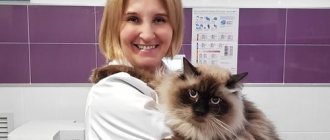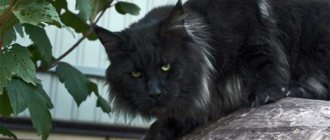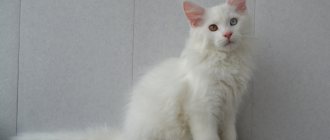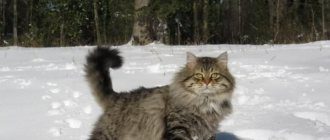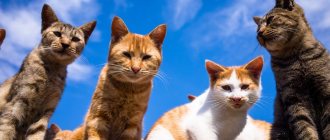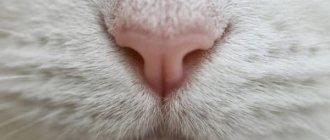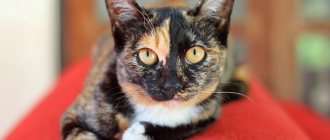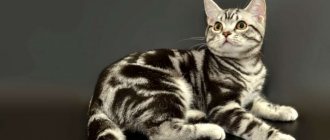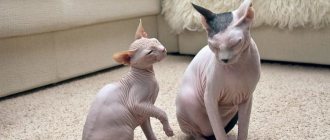Is there a yard breed?
Outbred cats make up 90% of the entire cat population of the planet. And no other breed can boast of such a variety of coat colors, body dimensions and characters as these felines have. The history of coexistence between humans and cats goes back almost 10 thousand years. In that distant time, cats were not divided into breeds. People were more interested in the practical benefits of pets. They have always been valued as excellent hunters of small rodent pests.
At different times, attitudes towards cats were ambiguous. The ancient Egyptians deified these animals, and in medieval Europe they were credited with a connection with evil spirits. Domestic or yard cats, descended from wild ancestors, were common on all continents. Differences in climate and nutrition led to a variety of characters and appearance.
The very concept of “breed” is very young – it is no more than 200 years old. Felinological organizations identify special traits and properties in individual cats, then prescribe and approve a standard with these unique characteristics, thereby giving the world a new purebred beauty.
Felinologists call yard cats outbred, although this statement can be considered erroneous, because the ancestors of all purrs were wild cats, which have different external characteristics and character, which is explained by different climates and ability to adapt.
Thus, native breeds with characteristic external data and character traits can be called yard breeds, because the distinctive characteristics of these purrs were formed thanks to nature, without the “selective” hand of man.
These native barn cats include:
- Turkish Angora.
- Celtic cat.
- Persian cat.
- Siberian cat.
- Siamese cat.
The difference between purebred and mongrel cats
At first glance, the differences lie on the surface. If a cat has reddish short hair, a characteristic color-point color and bright blue eyes, then no one doubts that this is a purebred Siamese. But brown pupils, a sixth toe or an overly large mask instantly exclude this aristocrat from the purebred group.
Which animals fall under the definition of outbred:
- In the first place is the culling of breeding animals. It includes all individuals that are not suitable for breeding and exhibition. Such cats cannot be called outbred, but they are also not considered to be among the elite cohort.
- Next come the mixed breeds - the owners did not keep track of the walking cat, but she delighted them with mixed offspring. The appearance may be impeccable, a fake pedigree can deceive an expert, but as soon as it comes to kittens, everything immediately falls into place. Mestizos do not guarantee quality children.
- The final group is ordinary outbred cats, at first glance one can immediately identify 10 generations of street strays. They come in all sizes, coat types and colors.
The listed animals belong to the group of domus - good companions for their owners, but without certain characteristics of the breed or with its unconfirmed characteristics.
Let's start by building a composition
Rule of thirds
You must mentally divide the picture into nine equal parts with two vertical and two horizontal lines. The main objects of the photograph should be located along the resulting lines and at their intersection.
Symmetry
It is not forbidden to violate the most important law of composition - the rule of thirds - and place the object in the center of the frame when you want to emphasize the symmetry of the object. With cats, such photographs can turn out to be very beautiful: they often take suitable poses while relaxing.
Contrast
The cat should not blend into the background (unless, of course, this is an artistic idea). Therefore, choose a background for shooting that contrasts with the color of the skin. Classic combinations: red cat on blue or green, white on black, black on red. Pay attention to the fact that the background color emphasizes the color of the cat's eyes. A white window sill or neutral-colored wallpaper without a pattern is perfect as a background at home.
Shooting point
To avoid perspective distortion, as a rule, you should shoot the subject while being at its level. In the case of a cat, this is the level of its eyes. Therefore, either lower yourself (on the floor, grass) or lift the cat (for example, onto a chair or stepladder). Considering cats' love of heights, this won't be difficult. You can also shoot the cat from the bottom up as it climbs trees or shelves.
Focusing
Cats in general do not have very expressive facial expressions, but they have very beautiful, attention-grabbing eyes. Therefore, you should always focus on your eyes. Pay attention to the differences in shapes, shades and conditions of the pupil in different breeds and in different lighting conditions. By the way, if you want the narrow pupil to dilate, attract the cat's attention with something rustling. At the moment of attack, the pupil expands almost to its maximum.
Frame composition
Photos usually turn out quite well if you just take a close-up of the cat. Of course, you need to make sure that there are no “cropped” ears, tails and paws. You can also place one or two objects in the frame, for example a classic ball of thread or a vase with a flower. But there should not be too many objects so that the emphasis remains on the hero of the photo shoot.
vvvita/Depositphotos.com
Features of the appearance of yard cats
Classification of outbred cats is carried out in standard ways: by weight and size, by coat length, by color.
By weight and size:
- large (over 7 kg);
- medium (4-7 kg);
- small (up to 4 kg).
Additionally, the height and length of a mongrel cat are considered. Sometimes the weight of the animal does not reach the required values due to its light bones, but its body is long and has high legs. Such cats are included in the first group. The same applies to small ones, when small height is compensated by significant weight.
Wool length:
- long-haired;
- semi-longhaired;
- shorthaired
The type of hair in cats is determined by a set of specific genes passed on to them from their parents: the L- allele is an attribute of short hair, and ll characterizes the preference for long and semi-long hair. Depending on the genetic pedigree of mongrel cats, long-haired parents may produce short-haired children.
Among yard four-legged inhabitants, owners of long hair are rarely found. Usually such animals are short-haired. Tailed mongrels, depending on the characteristics of the climate in which they were formed, are conventionally divided into 2 types: northern and southern. The mustachioed “northerners” have long, thick hair, while the “southerners” have short hair without a pronounced undercoat layer. It is impossible to meet a hairless barn cat. Even if a street kitten is born completely hairless, it is unlikely to live long in harsh conditions.
In color, the genotype also comes first. It is impossible to guess the color of the offspring of outbred cats in advance, and no one sets such a task.
The colors of the fur of yard cats are so varied that purebred individuals can envy them. There are animals that have a spotted color, which represents entire patterns. Among outdoor cats you can often see tri-colored ones. This suit has been considered lucky for a long time. Despite the variety of colors, the most common is light wool with dark stripes.
Street cats almost never produce kittens of rare exotic colors. For example, marble color (tbtb allele) exists only in a recessive form - it is suppressed by other genes. The probability of meeting two outbred cats with this genotype is close to zero.
“Not purebred” or non-standard genotype
The appearance of an unborn yard kitten is very difficult to predict, because it is born from a mixture of two or even several breeds. Therefore, color, coat length, eye color and other characteristics are always a pleasant surprise.
Breeds of yard cats are varied. The variety of coat colors of mongrels can be the envy of any exotic purr participating in championships. This can be a single coat color or a combination of two or even several shades. The patterns and markings on the base color also vary. A common color is dark stripes on a light background. It is this pattern that helps the animal camouflage itself in natural conditions and hunt successfully.
The fur of yard cats can be long or short, but what you definitely won’t find is the complete absence of fur on the animal.
The mongrels are in most cases medium in size, and their weight ranges from 3 to 6 kg.
The character of yard cats, unlike purebred cats, is varied. They are not characterized by aggression and touchiness. They generally show emotions very carefully.
Mustachioed mongrels love active games and appreciate the attention of household members. They can become attached to someone in particular or love everyone with the same love at the same time.
These cats have a negative attitude towards the absence of their owners and can even fall into a kind of “cat” depression. This is manifested by refusal of food, hair loss, etc. But this condition mainly applies to “apartment” cats that cannot freely go outside.
Character of outbred purrs
Where yard cats have a clear advantage over purebred cats is in their character traits and attitude towards their owners. By adopting a mongrel kitten, you can be sure that a creature has settled in the house who will be grateful to you all its life.
Outbred cats are restrained in showing emotions. It is as difficult to predict a pet's character as it is to predict its appearance. Some can be curious and restless. Others behave like born aristocrats, showing honor by the very fact of their existence.
Health and life expectancy
Most four-legged street dwellers are in good health and free of any genetic diseases. This feature was formed over centuries in wild conditions and was passed on to modern domesticated outbred cats.
Strong immunity is the basis for the long life of tailed mongrels (which does not negate the need for their vaccination and treatment for parasites). On average they live about 10–12 years. Among them there are often true centenarians, living up to 16–17 years.
Domestic mongrel pets usually live much longer than their counterparts who were not lucky enough to find loving owners. This is influenced by a well-fed life, regular care and the opportunity to use veterinary help in case of illness. Street animals must search for food on their own and often die, unable to cope with disease and hunger, becoming a victim of a dog attack or freezing to death.
Some useful tips for a photo shoot with a cat
So, to take beautiful cat photos, you need to remember simple rules.
- Get your pet's attention. This is the only way you can get the furry one to look into the frame. To do this, you can rustle the candy wrapper or snap your fingers at the level of the lens. To direct the cat's attention to the side, throw a small pebble in that direction.
- Be patient. Don't expect good shots right away and don't be upset if you didn't manage to take a beautiful photo the first time. Cats are very capricious animals with whom you need to build trusting relationships.
- Use continuous shooting. This way you can increase the chances of creating an interesting shot.
- Avoid flash. A bright sudden light can frighten the furry one, and it will be difficult to restore his mood.
- Keep your distance. If your baby is playing with his toys, just don’t interfere and enjoy the fun shots.
You will find even more ideas for photos with a cat or other pets on our blog.
Pet care
To comfortably accommodate a mongrel animal, you need:
- arrange a sleeping place for him in a warm, quiet room, where there are no drafts;
- tray with or without filler;
- scratching post;
- bowls for food and water;
- walking harness;
- play complex and (or) toys.
Yard cats also need the care and attention of their owners:
- Grooming . The coat needs to be brushed regularly. The frequency of the procedure depends on the length of the animal's fur. For short-haired dogs, it is enough to do this 2 times a month, and for long-haired dogs, once a week.
- Eye care . They need to be inspected and wiped with a damp swab when dirty.
- Water treatments . There are very few cats that favor this process, so you should not bathe your pet too often. Usually mongrels themselves monitor the cleanliness of their fur. If the cat returns dirty after active street festivities, you can give it a bath.
- Nutrition . It should be balanced and include both proteins (meat, fish, eggs, fermented milk) and carbohydrates (porridge, vegetables, crackers, root vegetables).
Let's move on to the technical aspects of shooting
Lighting
The long shutter speeds required when shooting in low light are only suitable for sleeping cats. It is better to photograph vigorous cats actively moving their skin, whiskers, and ears in good natural light. Ideally, on the street in the morning or evening (“golden hours”) or on the balcony, where the cat will happily bask in the sun: the model’s “smile” is guaranteed.
Flash
Flash should be used to a minimum. In any case, this applies to the camera’s built-in flash. Firstly, too harsh lighting will be unpleasant for the cat. Secondly, the color of the skin may be distorted, and the eyes will turn out to have glare. It’s better to do without a flash altogether or, as a last resort, use a diffuser. The ideal option is an external flash that will not hit you head-on.
Shooting mode
Cat photography is the closest thing to portrait photography, so the most suitable mode would be the camera's portrait or aperture-priority mode. The wider the aperture, the more the background will be blurred - with a non-uniform background this can give good results. Sports mode or fast shutter speed settings are great for photographing cats in motion.
White balance
Even with a well-chosen background, whenever possible, try to check whether the camera reproduces the colors correctly. White spots should turn out white. So take a couple of test shots and adjust the white balance manually. As a last resort, if the color could not be reproduced correctly, try converting the photo to black and white.
Photosensitivity
If you want to take a photo in low light, you still shouldn't resort to using a flash. Better to increase ISO. But it's not easy to avoid noise in the image, so take photos with different light sensitivity settings so you can choose the best one later.
Lenses
A telephoto lens will be very useful in a photo shoot with a cat on the street. With it, you can maintain a distance sufficient for the cat to relax and the pictures to turn out natural. A telephoto lens with built-in image stabilization will ensure shooting at longer shutter speeds without blurring the image.
papadimitriou/Depositphotos.com
Advantages and disadvantages
Despite the fact that yard cats do not have such exclusive characteristics as their purebred counterparts, they are nevertheless not without merit.
- Lasting immunity. Breeding breeds using selective breeding methods has greatly weakened the immune system of animals. This is why the life expectancy of street cats is many times higher than that of purebred pets. Yard cats have strong protective functions of the body and are able to resist many infections.
- Personality Such animals tend to be docile in nature. They become very attached to the owner who picked them up on the street.
- Reproduction. Since yard cats do not need a purebred partner, finding a mate for them to reproduce will not be difficult.
- Indispensable in the household. Outdoor cats are excellent mouse hunters. Nature endowed the animal with these qualities, and it is among the domestic representatives of the family that this instinct is much more developed.
- Price. You don't need a big investment to get a pet. You can pick up a cute, albeit not purebred, kitten on the street. Some cats even choose their own owner, coming to visit and “imposing” themselves.
- Exhibitions for yard cats. You heard right. Indeed, there are special exhibitions designed for outbred cats. On them, judges evaluate the external characteristics of the animal and its grooming.
The main and, perhaps, the only drawback of street cats is their unpredictability of character. Stray cats are careful in expressing their emotions, therefore, when taking such an animal from the street, you cannot be sure that it has a calm, easy-going disposition. Otherwise, mustachioed-striped tramps successfully compete with their purebred brothers.
Strengths of mongrels
Each purebred cat is unique and valued for some of its exceptional characteristics. Yard mustaches may in some ways not be comparable to their purebred counterparts, but they have a lot of advantages:
- Health. The life expectancy of mongrels is usually longer than that of purebred purrs, because the former have a stronger and more lasting immunity to most street infections. Selection work weakens the protective functions of the cat’s body.
- Temperament. Domestic breeds have the most flexible and gentle character. If such a cat is picked up on the street, then its joy will know no bounds - it will become attached to its owner for life.
- Knitting. Finding a partner for a yard pet will not be difficult. Most likely you will have many options to choose from. Waiting for a new offspring is always a mystery, because it is impossible to predict what coat color, color and eye shape the future kittens will have. It is quite possible that such a kitten will become the founder of a new breed.
- Help with housekeeping. Catching an annoying rodent will not be difficult for a mongrel; they have a well-developed natural instinct.
- Exhibitions. There are exhibitions for outbred pets, where the external characteristics of purrs and their grooming are assessed. It’s great that yard breeds also have the opportunity to show themselves in all their glory.
- Price. Anyone can buy a yard pet. Usually they come to visit themselves, offering to leave themselves. In this case, it is almost impossible to refuse.
Choosing a purebred cat
The decision is best made after the consent of all family members. Attention is drawn to the following circumstances:
- Age. A young cat will more easily enter a new environment and adapt to it. She had not yet developed the habits of a wandering life, and her character had not hardened in the struggle for survival.
- Health. Ordinary street kittens traditionally have strong immunity and natural endurance. A healthy kitten should be playful, easy to run and jump, with shiny, even fur, pink gums and clean mucous membranes.
Appearance also plays a role in the selection process. They look at her first of all - after all, the aesthetic desire to own a beautiful animal overshadows everything.
The task is greatly simplified when it comes to the children of a domestic mongrel cat. Here the parents are already known (at least one of them), the kitten is under supervision and warm, and the mother cat has adequate feeding and the opportunity to raise her offspring.
If you pick up a mongrel kitten on the street, you risk bringing a sick animal into your home. Be sure to take him to the vet right away. A little street child may have lichen or fleas. It may be infected with an infection or worms. If a purebred parent took part in the birth of a kitten, then, in addition to distinctive features, the baby can inherit genetic diseases inherent in the breed.
Plot ideas and little tricks
- Find interesting scenes by filming different moments of a cat’s life : sleep, lunch, play, hunting, washing. Give your cat new things: let him play around, and you will have an interesting photo session. Put a nice collar on your cat or, if possible, clothes.
- If you are photographing your pet, you should not photograph him only in classic poses. Try to convey his special features. After all, you probably sometimes tell your friends about them, so show them off! If you are photographing someone else's cat, ask the owner about its personality.
- Pay attention to studying the characteristics of different breeds. For example, in the case of the British, it is worth emphasizing their massiveness and arrogant look. Cornish Rex cats have a very graceful build and are usually photographed in arched poses. Emphasize the beauty of the Angora cat's tail, the profile of cats of the Siamese-Oriental group.
- Always be careful when outdoors, as cats tend to panic at loud noises or at the sight of dogs. It is better to film the animal in a fenced area, because you do not want to lose your pet. You shouldn’t force a cat up a tree: an uncomfortable position and a frightened look will give away a bad move. Let the cat get used to it, and it will take interesting poses on its own.
- Kittens are great models. It is not difficult to attract their attention: they are captivated by every little thing. Give them any object and they will explore and play with it. As a rule, kittens are not yet afraid of other animals. But there is also a peculiarity - the baby gets tired very quickly, so you need to take pictures quickly, without delaying the framing of the frame.
- Particularly interesting, although more complex, are photo sessions of cats with other animals: other cats, dogs, guinea pigs - or with children. Here, however, you will need a little more patience, because all participants in the photo shoot will have to get used to each other.
- Experiment with macro. Photos of the nose, mustache, teeth, eyes, ears, paw pads can be very interesting. Just don’t get carried away: a few of these pictures will be enough.
https://widefon.com
- The main rule when working with a cat: under no circumstances try to raise your voice or punish it, do not use force or intimidation. Remember the peculiarities of the psyche of these graceful animals: they do not understand negative reinforcements. It’s better if you have an assistant who can direct your pet’s attention. But the main assistant in photographing a cat is patience.
